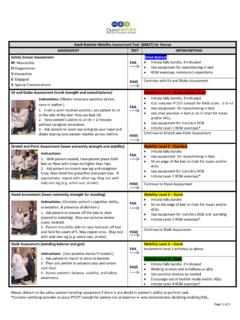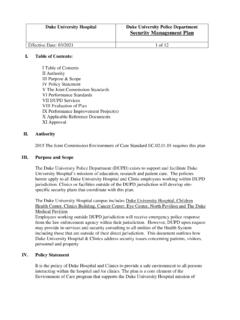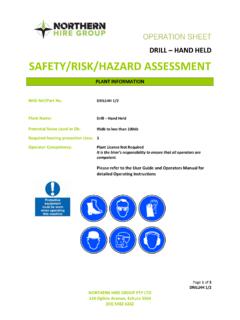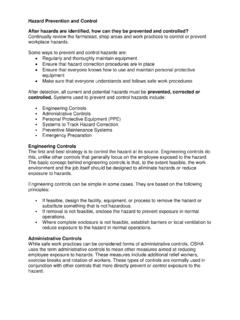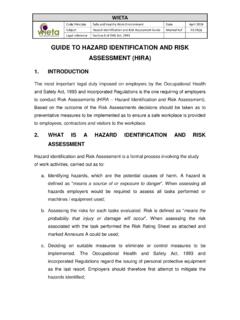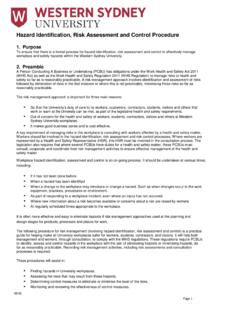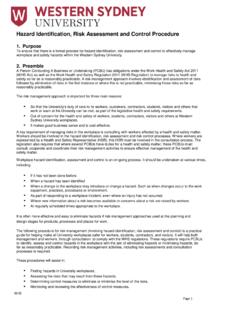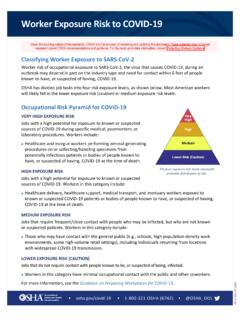Transcription of Personal Protective Equipment (PPE) Hazard Assessment ...
1 Personal Protective Equipment (PPE) Hazard Assessment Certificate Instructions Based on the hierarchy of controls, PPE is a last resort. Personal Protective Equipment alone should not be relied upon to provide protection against hazards but should be used in conjunction with engineering controls, administrative controls, and procedural controls. This document addresses eye, face, head, hand, foot, torso, respiratory, noise, and fall protection. It will serve as the Personal Protective Equipment (PPE) Certification document required to satisfy the federal requirements of the Occupational Safety and Health Administration (OSHA) Standard, 29 CFR Subpart I Personal Protective Equipment .
2 General Guidelines The PPE Hazard Assessment can be conducted for an area, a job category or for an individual by selecting and filling in the appropriate box. The assigned evaluator shall include their name, department/division being assessed, and the date. Completed assessments must be accessible to employees and inspectors and updated when needed. PPE Hazard Assessment INSTRUCTIONS STEP 1: INFORM AFFECTED EMPLOYEES OF THE PROCESS: Affected employees from each work area that is being assessed should be involved in the process. Discuss the reasons for the survey and the procedures being used for the Assessment .
3 Review the job procedures, potential hazards and the PPE currently in use. Step 2: Review data: Reports of work related injuries or illnesses, near miss events and reported safety concerns are sources of data that can provide helpful information for assessing hazards . Step 3: Conduct a walk through survey: The purpose of the survey is to identify sources of hazards to employees. Observe the following: layout of the workplace, location of the employees, work operations, hazards and places where PPE is currently used including the device and reason for use. Using the form, check the type of Hazard (s) present within each section (organized by body part).
4 Further descriptions can be provided in the adjacent box. Consideration should be given to the following basic Hazard categories: 6/28/2019 1. Impact (falling/flying objects)2. Penetration (sharp objects piercing foot/hand)3. Compression (roll over or pinching objects)4. Chemical exposure (inhalation, ingestion, skin contact, eye contact or injection)5. Temperature extremes (heat/cold)6. Dust/flying debris (grinding, chipping, sanding, etc.)7. Fall (slip/trip, scaffolds, elevated work)8. Radiation (non ionizing: UV/IR/light, welding, brazing, cutting, furnaces, etc.)9. Noise (mechanical rooms, machines, cage washing, jackhammers, etc.)
5 10. Electrical (shock, short circuit, arcing, static)Step 4: Select PPE: After considering and/or planning for other controls, select the PPE which provides at least the minimum level of protection required to protect employees from the hazards . Using the form, note the appropriate PPE in the required PPE box. For help with proper PPE selection, contact OESO or consult the guides found on the OESO Personal Protective Equipment webpage: Step 5: Make Document Accessible: Once completed, signed and dated, store the form either electronically or as a hard copy in a location easily accessible to employees and inspectors.
6 Step 6: Revise Protocol: Update departmental protocols with the new or modified PPE requirements if applicable. Step 7: Reassess the workplace as necessary by identifying and evaluating: 1. New Equipment and processes2. Accident records3. Suitability of previously selected PPESee the attached completed example of the PPE Hazard Assessment Certificate. The OESO Occupational Hygiene and Safety Division office can be reached at 919-684 5996 if there are questions regarding this PPE Hazard Assessment Certification form. 6/28/2019 PPE Hazard Assessment FORM (check treviewing I am box):appropriateA worksite Specify location:A single employee s job description Name of employee:Position Title:A job description for a class of employees Position Titles:Location:Your Name: Department/Division:Date: EYE hazards : Tasks that can cause eye injury include: working with chemicals or acids; UV lights; chipping, sanding, or grinding; welding; furnace operations; and metal andwood working.
7 Check the appropriate box for each Hazard :Description of Hazard (s):Required PPEC hemical Exposure High Heat/Cold Dust/Flying Debris Impact UV/IR Radiation Other: HEAD/NECK/FACE hazards : Tasks that can cause head/neck/face injury include: working below other workers who are using tools or materials that could fall, workingon energized electrical Equipment or utilities, and working in trenches or confined the appropriate box for each Hazard :Description of Hazard (s):Required PPEC hemical ExposureDust/Flying DebrisImpactUV/IR RadiationElectrical ShockOther:FOOT hazards : Tasks that can cause foot injury include: exposure to chemicals or acids, welding or cutting, materials handling, renovation or construction, and electricalwork.
8 Check the appropriate box for each Hazard :Description of Hazard (s):Required PPEC hemical Exposure High Heat/Cold Impact/Compression Electrical Puncture Slippery/Wet Surfaces Other: PPE Hazard Assessment CERTIFICATEHAND hazards : Hand injury can be caused by: work with chemicals or acids, exposure to cut or abrasion hazards (for example, during demolition, renovation,woodworking, or food service preparation), work with very hot or cold objects or materials, and exposure to sharps. Check the appropriate box for each Hazard :Description of Hazard (s):Required PPEC hemical Exposure High Heat/Cold UV/IR Radiation Electrical Shock Puncture Cuts/Abrasion Other: BODY hazards : Injury of the body (torso, arms, or legs) can occur during: exposure to chemicals, acids, or other hazardous materials; abrasive blasting; welding,cutting, or brazing; chipping, sanding, or grinding; use of chainsaws or similar Equipment .
9 And work around electrical the appropriate box for each Hazard :Description of Hazard (s):Required PPEC hemical Exposure High Heat/Cold Impact/Compression Electrical Arc Cuts/Abrasion Other: FALL hazards : Personnel may be exposed to fall hazards when performing work on a surface with an unprotected side or edge that is 4 feet or more above a lower level, or10 feet or more on scaffolds. Fall protection may also be required when using vehicle man lifts, elevated platforms, tree trimming, performing work on poles, roofs, or fixed ladders. Check the appropriate box for each Hazard :Description of Hazard (s):Required PPEFall Hazard NOISE hazards : Personnel may be exposed to noise hazards when working in mechanical rooms; machining; grinding; sanding; cage washing; dish washing; workingaround pneumatic Equipment , grounds Equipment , generators, chillers, motors, saws, jackhammers, or similar Equipment .
10 Check the appropriate box for each Hazard :Description of Hazard (s):Required PPEN oise Hazard RESPIRATORY hazards : Personnel may be exposed to respiratory hazards that require the use of respirators: during emergency response, when using certainchemicals outside of a chemical fume hood; when working with hazardous powders; when entering fume hood plenums, when working with animals; when applying paints or chemicals in confined spaces; when welding, cutting, or brazing on certain metals; and when disturbing asbestos, lead, silica, or other particulate hazards . Check the appropriate box for each Hazard :Description of Hazard (s):Required PPEC hemical exposure Particulate exposure Other: I certify that the above Hazard Assessment was performed to the best of my knowledge and ability, based on the hazards presenton this date.


